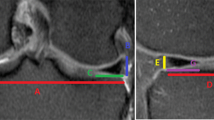Abstract
Objective. The purpose of this study was to clarify the nature of Osgood-Schlatter disease (OSD) using MR images.
Design. Thirty boys (40 knees) with OSD diagnosed by clinical symptoms and signs were investigated with MRI. Longitudinal evaluation was undertaken in 22 patients and the mean follow-up was 1.5±0.9 years. MR examinations were performed at least every 6 months in most cases. When a patient's symptoms changed, MRI was repeated and in cases where the initial MR examination showed an early or progressive stage of OSD, MRI was undertaken every month where possible. All MR examinations were performed in the sagittal plane with a 0.2 T imager.
Results. MR images were classified into five stages as follows: normal, early, progressive, terminal and healing. The stage of 11 knees (28%) did not change during the course of the study and 21 knees (53%) showed a change of at least one stage. Eight knees (20%) did not have follow-up MR studies. The initial MR examination was normal in nine knees. Eight knees were at the early stage at presentation. MR images showed edema-like changes around the tibial tuberosity. Ten knees were classified as in the progressive stage at the initial presentation and six knees were classified in this group during progression on follow-up MRI. MR images showed partial avulsion of the secondary ossification center, which was seen to be being pulled proximally. Eleven knees were at the terminal stage on presentation, where the avulsed parts of the secondary ossification center had become completely separated. Two knees were classified as in the healing stage at presentation and 19 knees progressed to the healing stage from the normal, early and progressive stages. The MR images showed the separated part that did not create the ossicle had recovered by osseous healing. On the other hand, radiographs of the early stage appeared almost normal, and in the progressive stage could not show the avulsed parts.
Conclusions. We clarified the progress of OSD with MRI. The process of OSD started from the apophyseal stage and a tear appeared in the secondary ossification center, widening to an opened shell-like shape. This damage progressed to an ossicle in some cases. In short, the ossicle was formed from an avulsed portion. It was very difficult to show the course of OSD with radiography. MR images were especially useful for revealing early and progressive lesions of OSD.
Similar content being viewed by others
Author information
Authors and Affiliations
Additional information
Electronic Publication
Rights and permissions
About this article
Cite this article
Hirano, A., Fukubayashi, T., Ishii, T. et al. Magnetic resonance imaging of Osgood-Schlatter disease: the course of the disease. Skeletal Radiol 31, 334–342 (2002). https://doi.org/10.1007/s00256-002-0486-z
Received:
Revised:
Accepted:
Issue Date:
DOI: https://doi.org/10.1007/s00256-002-0486-z




